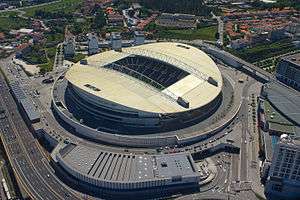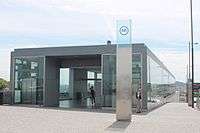Estádio do Dragão
The Estádio do Dragão (Portuguese pronunciation: [(ɨ)ˈʃtaðju ðu ðɾɐˈɣɐ̃w]; English: Dragon Stadium) is an all-seater football stadium in Porto, Portugal, and the home ground of FC Porto since 2003. It has a seating capacity of 50,033, making it the third largest football stadium in Portugal.
 Aerial view of the stadium UEFA | |

| |
| Location | Porto, Portugal |
|---|---|
| Coordinates | 41.161758°N 8.583933°W |
| Public transit | |
| Owner | FC Porto |
| Operator | Porto Estádio (FC Porto Group) |
| Executive suites | 96 |
| Capacity | 50,033 |
| Record attendance | 52,000 (16 November 2003) FC Porto 2–0 FC Barcelona |
| Field size | 105 x 68 m |
| Surface | Grass |
| Scoreboard | Samsung P10 LED screens[1] |
| Construction | |
| Opened | 16 November 2003 |
| Construction cost | €125 million |
| Architect | Manuel Salgado |
| General contractor | Somague |
| Tenants | |
| FC Porto (2003–present) Portugal national football team (selected matches) | |
| Website | |
| Official website | |
Designed by Portuguese architect Manuel Salgado, the stadium was constructed to replace Porto's former ground, the Estádio das Antas, along with becoming one of the host venues for the UEFA Euro 2004 final tournament. The inauguration took place on 16 November 2003 with a friendly match against Barcelona, setting an attendance record of 52,000 spectators.[2]
A UEFA category four stadium, it has held several international club and national team competition matches, including the 2019 UEFA Nations League Final.
Construction and inauguration
Construction works began in late 2001, and were completed in November 2003, some months after what was expected, since in February 2002, Porto mayor Rui Rio changed the estate distribution, criticizing the plan for including high-scale housing and shopping for the area.[3] These actions forced the chairman of FC Porto, Jorge Nuno Pinto da Costa, to halt all building operations, which were only resumed after a consensus was reached.[4]
Designed by Portuguese architect Manuel Salgado[3] and built by Portuguese contractor Somague, it cost €97,755,318, of which €18,430,956 was subsidized by the government. To help underwrite costs, each stand carries one or two sponsor names: Super Bock (south), tmn (east), meo (west), and Coca-Cola (north stand). Away fans are placed in the right corner of the upper tier of the east stand, while home Ultra groups, Super Dragões and Colectivo Ultras 95, occupy the south stand and the north stand, respectively, like on the old stadium.
The stadium was inaugurated on November 16, 2003, with a match against FC Barcelona, which featured the debut of a 16-year-old Lionel Messi in the Spanish side. Porto won 2–0 with goals by Derlei and Hugo Almeida. Due to severe turf problems, however, Porto was forced to return and play in the old Estádio das Antas, until the turf was replanted by mid-February 2004.
The stadium is characterized by a frame of 21 000 meters squared of azulejos.[5]
Naming
Prior to the inauguration, the stadium's name was debated internally between elements of Porto's administration, with various alternatives in consideration, such as retaining the old name, Estádio das Antas (officially, unlike the former stadium), or name it after some of the club's biggest historical figures like former player Artur de Sousa Pinga, manager José Maria Pedroto or president Jorge Nuno Pinto da Costa, the latter being, the one with most gathered consensus but ended dismissed by the president himself.[6] After a deliberation period, the name Estádio do Dragão was revealed to the general public.[7]
"The Dragon is in our symbol and the coat of arms of the city, there was no better to symbolize the strength and vitality of FC Porto, neither the certainty of our future. There is no name that mythologically or ideologically conveys the will of new conquests like that of the Dragon."
— Pinto da Costa, on the stadium name (May 2003)[8]
International matches
Portugal national team matches
The following national team matches were held in the stadium.
| # | Date | Score | Opponent | Competition |
|---|---|---|---|---|
| 1. | 12 June 2004 | 1–2 | Euro 2004 Group Stage | |
| 2. | 12 October 2005 | 3–0 | 2006 World Cup qualification | |
| 3. | 21 November 2007 | 0–0 | Euro 2008 qualifying | |
| 4. | 28 March 2009 | 0–0 | 2010 World Cup qualification | |
| 5. | 8 October 2010 | 3–1 | Euro 2012 qualifying | |
| 6. | 7 October 2011 | 5–3 | Euro 2012 qualifying | |
| 7. | 16 October 2012 | 1–1 | 2014 World Cup qualification | |
| 8. | 29 May 2016 | 3–0 | Friendly | |
| 9. | 5 June 2019 | 3–1 | 2019 Nations League Semi-finals | |
| 10. | 9 June 2019 | 1–0 | 2019 Nations League Final |
UEFA Euro 2004
Constructed to become one of the venues of the UEFA Euro 2004 tournament, it staged the inaugural match between hosts Portugal and eventual winners Greece, as well as three group stage, one quarterfinal, and one semifinal fixtures.
| Date | Time (WEST) | Team #1 | Result | Team #2 | Round | Attendance |
|---|---|---|---|---|---|---|
| 12 June 2004 | 17:00 | 1–2 | Group A | 48,761 | ||
| 15 June 2004 | 19:45 | 1–1 | Group D | 48,197 | ||
| 18 June 2004 | 19:45 | 1–1 | Group C | 44,926 | ||
| 27 June 2004 | 19:45 | 3–0 | Quarter-finals | 41,092 | ||
| 1 July 2004 | 19:45 | 1–0 (aet) | Semi-finals | 42,449 | ||
2019 UEFA Nations League Finals
One of the venues of the 2019 UEFA Nations League Finals.
| Date | Time (WEST) | Team #1 | Result | Team #2 | Round | Attendance |
|---|---|---|---|---|---|---|
| 5 June 2019 | 19:45 | 3–1 | Semi-finals | 42,415 | ||
| 9 June 2019 | 19:45 | 1–0 | Final | 43,199 | ||
Other uses
.jpg)
A major source of income granted by the infrastructure is the planned capability to monetize on organizing events outside of regular football matches. Those extend from business meetings, congresses, summits, festivals, expos and other sports competitions.[9] For example, the ROC committee picked the stadium to host the 2009 Race of Champions South Europe Regional Final, therefore, the grass pitch was converted into an asphalt course in order to accommodate the race.[10] The 2019 ESSMA Summit is also noteworthy by having joined several clubs, leagues and federations representatives together at the venue to discuss matters on the developments and trends of the football industry.[11]
In addition, through different music promoters and specialized event management companies, the stadium already served as a concert venue to four international tour schedules from recognized musical artists along with selected opening acts.
| Date | Performer(s) | Tour / Event | Attendance | Ref. |
|---|---|---|---|---|
| 12 August 2006 | The Rolling Stones The Dandy Warhols | A Bigger Bang Tour | 47,801 | [12] |
| 18 May 2012 | Coldplay Marina and the Diamonds / Rita Ora | Mylo Xyloto Tour | 52,457 | [13] |
| 10 June 2013 | Muse We Are the Ocean | The 2nd Law World Tour | 45,000 | [14] |
| 13 July 2014 | One Direction D.A.M.A | Where We Are Tour | 45,001 | [15] |
Access and transportation

.jpg)
Access by vehicle is possible through the VCI (Via de Cintura Interna), a roadway that passes right next to the stadium, granting a direct connection. In the event of coming from the city center, driving down the main Alameda da Antas is another viable route towards the destination. In spite of this, the recommendation is the use of the public transports, which results in a better flux of public movement around the perimeter. Having its own station combined with the infrastructure, the metro functions as the main way of reaching the stadium, with different lines linking the various city areas and a direct connection to the international Francisco Sá Carneiro Airport. Alternatively, the STCP bus service also grants routes for the purpose and there are 150 bicycle parking spots available.[16][17]
| Transport | Lines | Stations / Routes |
|---|---|---|
Metro |
Estádio do Dragão ⇄ Senhor de Matosinhos | |
| Estádio do Dragão ⇄ Póvoa de Varzim | ||
| Estádio do Dragão ⇄ Airport | ||
| Fânzeres ⇄ Senhora da Hora | ||
Bus |
401 | Bolhão (Mercado) ⇄ S. Roque |
| 806 | Marquês ⇄ Av. Carvalha (Via Portelinha) |
References
- Rocha, Óscar (16 August 2016). "Samsung 'dá' inteligência ao Estádio do Dragão" [Samsung "gives" intelligence to Estádio do Dragão] (in Portuguese). Sol. Retrieved 18 December 2018.
- Bandeira 2012, p. 128.
- Carrapatoso, Miguel Santos (12 January 2018). "Como Rui Rio governou o Porto. 12 histórias para conhecer melhor o novo líder do PSD" [How Rui Rio has governed Porto. 12 stories to know the new PSD leader better] (in Portuguese). Observador. Retrieved 31 March 2019.
- "Obras das Antas suspensas" [Construction in Antas suspended] (in Portuguese). Record. 2 March 2002. Retrieved 31 March 2019.
- "Aniversário do Dragão celebrado com azulejos e relógio" [Dragon's Birthday celebrated with tiles and clock] (in Portuguese). Record. 16 November 2004. Retrieved 17 February 2019.
- "Pinto da Costa recusa dar o seu nome ao futuro estádio" [Pinto da Costa refuses to give his name to the future stadium] (in Portuguese). Record. 23 April 2003. Retrieved 17 February 2019.
- "Estádio do Dragão colheu unanimidade entre a direcção" [Estádio do Dragão won unanimity among the administration] (in Portuguese). Record. 14 May 2003. Retrieved 17 February 2019.
- ""Estádio do Dragão" é o nome do futuro recinto do FC Porto" ["Estádio do Dragão" is the name of the future venue of FC Porto] (in Portuguese). Record. 13 May 2003. Retrieved 17 February 2019.
- Brito, Paula (17 May 2013). "Festas no Dragão já valem mais de um milhão de euros (com vídeo)" [Festivals in the Dragão are already worth more than one million euros (with video)] (in Portuguese). Dinheiro Vivo. Retrieved 17 February 2019.
- "Portugal to Stage First Race of Champions Regional Final". ROC. 14 September 2009. Retrieved 17 February 2019.
- "Strong ECA member involvement at fifth ESSMA Summit hosted by FC Porto". ECA. 23 January 2019. Retrieved 17 February 2019.
- Belém, Joana (11 August 2006). "Rolling Stones tocam no maior palco já montado em Portugal" [Rolling Stones play the biggest stage ever set in Portugal] (in Portuguese). Diário de Notícias. Retrieved 17 February 2019.
- Barros, João Pedro (19 May 2012). "Coldplay, os príncipes do rock de estádio" [Coldplay, the princes of stadium rock]. Ípsilon (in Portuguese). Público. Retrieved 17 February 2019.
- Barros, João Pedro (12 June 2013). "Muse fizeram render o seu repertório épico" [Muse rendered their epic repertoire]. Ípsilon (in Portuguese). Público. Retrieved 17 February 2019.
- Moço, João (14 July 2014). "Regresso triunfal dos One Direction no Estádio do Dragão" [One Direction triumphant return at Estádio do Dragão] (in Portuguese). Diário de Notícias. Retrieved 17 February 2019.
- "Estádio do Dragão". The Stadium Guide. Retrieved 17 February 2019.
- "Estádio do Dragão inaugura 150 lugares de estacionamento para bicicletas" [Estádio do Dragão inaugurates 150 parking spaces for bicycles] (in Portuguese). greensavers. 23 August 2013. Retrieved 17 February 2019.
Bibliography
- Bandeira, João Pedro (2012). Bíblia do FC Porto (in Portuguese). Lisbon: Prime Books. ISBN 9789896550943.CS1 maint: ref=harv (link)
External links
| Wikimedia Commons has media related to Estádio do Dragão. |
| Preceded by None |
UEFA Nations League Final venue 2019 |
Succeeded by To be determined |
.jpg)